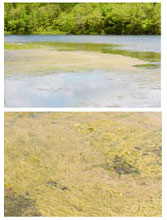Please document and report algal blooms (green muck, green slime) in the Woodens River Watershed
The Mysterious Algal Bloom on Black Point Lake
WRWEO member Bob Chambers reports that algal blooms develop in May around the outlet of a stream coming from Lizard Lake and, over a period of about 3 weeks, become quite extensive. Then they die back. Bob first noticed the bloom in 2003 and it seems to be increasing in severity each year. In 2009, Bob took water samples from Black Point Lake, Lizard Lake and the stream going from Lizard Lake to Black Point Lake and had them analyzed for total phosphorus. Phosphorus levels were highly elevated in the stream. Bob commented:
"The phosphate level in
Lizzard is twice that of Black Point. I'm not sure why this is so, but Lizzard is a
headwater lake. It is spring fed. There are houses on it, but there is no evidence that
they are contributing to the high [P]. The little stream from Lizzard winds through a
swamp with very little flow. The swamp is full of plant material both alive and dead.
The stream picks ups all sorts of organic material from the swamp… By the time it arrives at Black Point, its [P] is 4 times higher than the average
lake level. The little stream is furnishing all sorts of nutrients not just phosphate.
The algae bloom starts right where the stream comes in and then spreads."
Fortunately, you can rake filamentous algae, and that is exactly what we did. Most of
the algae is now fertilizing our gardens, but it will be back next year, and it is ucky
stuff!
Bob concluded that this bloom is associated with natural phenomena. He was right about it reoccurring. In May of 2010. Bob invited WRWEO Co-chairs Richmond Campbell and David Patriquin to have a look at the developing algal bloom, and we walked the stream together.
See more details, photos
While the immediate cause of the bloom seems pretty clear from Bob's data- the stream picks up phosphorus as it runs though the swampy area - why these blooms have begun only relatively recently (2003 and later) is a mystery. What has happened in the swamp to cause these large releases of phosphorus, when, evidently, they did not occur historically (Bob has lived in the area since the early 1980s). The swamp area is pretty undisturbed; there has been some trail work, but that post-dates the beginning of the blooms. One possible explanation relates to acid rain, but there may be others.
Reports on other blooms could help identify causes, and possible remedial measures.
Bob Chambers is a retired biochemist and resident on Black Point Lake. Over the years, Bob has been very active in monitoring water quality in the upper Woodens River Lakes and streams. Costs for some of the recent analyses were covered by an anonymous donor to WRWEO. |
|
Are algal blooms becoming more widespread in the streams and lakes of the Woodens River Watershed?
May 13, 2010: We are asking residents and visitors to streams and lakes of the Woodens River Watershed to help us answer this question and, as well, to help us identify possible causes. Observations on algal blooms in streams and lakes in other watersheds on the Chebucto Peninsula are also pertinent.
What to look for
Typically the algal blooms appear as masses of "green muck" or "green slime", often with large entrapped bubbles, close to shore. Winds may cause the algae to pile up in certain areas. They may be transient or long lasting. As the algae dies, it discolors, becoming brown to black in color. If the blooms become extensive, they are unpleasant for swimmers, make unsightly and sometime smelly accumulations on shore, and degrade fish habitat. Sometimes the blooms are diffuse, giving the water a cloudy green appearance.
Causes
Algal blooms in fresh water are commonly associated with elevated levels of phosphorus, a plant nutrient. Increased phosphorus can be due to a variety of causes, some of them man-made and some natural, or more or less natural. For example, if a bloom occurred near a storm sewer outlet, then input of phosphorus from pet feces, lawn fertilizer and soap residues washing into the storms sewer might be suspected. Improperly functioning septic systems could be another man-made cause.
However, sometimes blooms occur without any obvious human disturbance. Bob Chambers has documented such a case near his residence on Black Point Lake. (See Box)
How you can help
We are asking residents and visitors to the streams and lakes of the Woodens River Watershed to report instances of algal blooms to us so that we can begin to assess how serious a problem they are or might become and, also, to give us clues to their causes. Observations on streams and lakes in other watersheds on the Chebucto Peninsula are also pertinent and would be welcomed.
Please provide whatever information you can in the following categories:
1. Observer. Please provide name, address, phone and e-mail address.
2. Date of report
3. Where was the bloom sighted? Provide a map or verbal description; GPS coordinates as available.
4. When was it first sighted this year? (e.g., early May, mid May....)
5. Have you noted it in previous years?
6. Does the bloom appear to emanate from a certain area? Describe.
7. How large an area does the bloom cover?
8. As of the date of the report, had it begun to dissipate?
9. Other comments. Photos would be helpful.
Please send this information to:
wrweo@yahoo.ca
or by mail to:
WRWEO
3650 Hammonds Plains Road
Suite 14, Unit 300
Upper Tantallon
Nova Scotia B3Z 4R3
|

